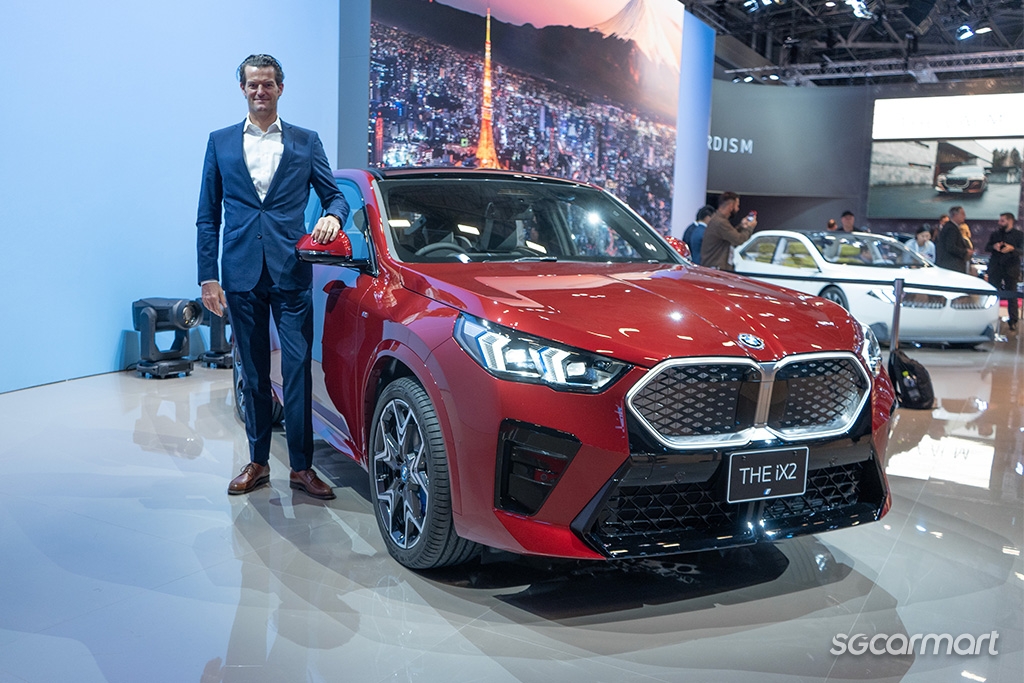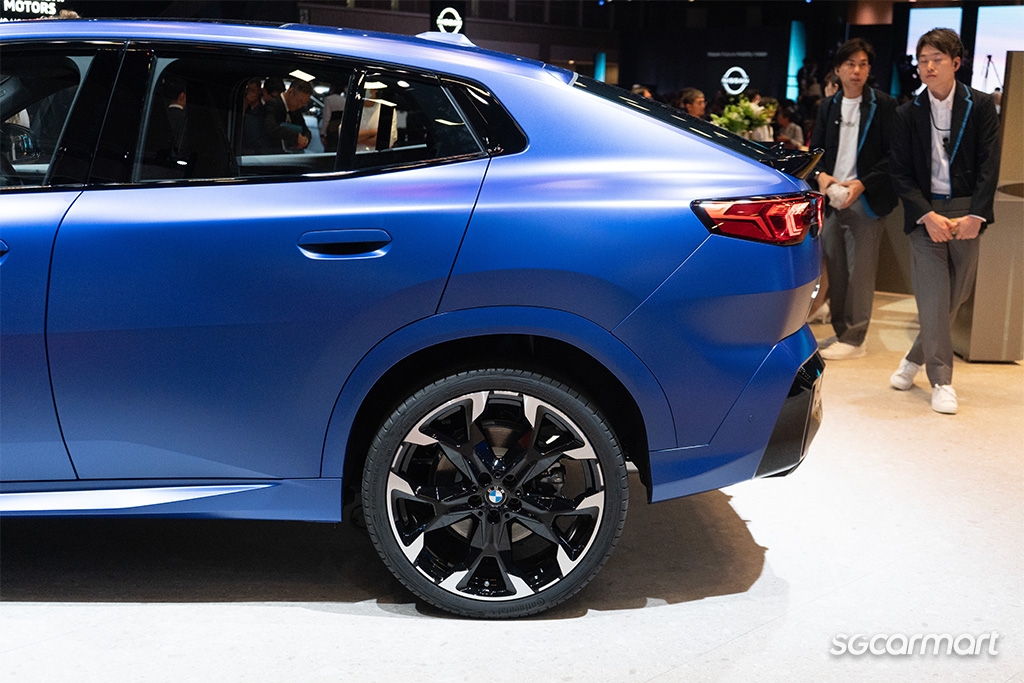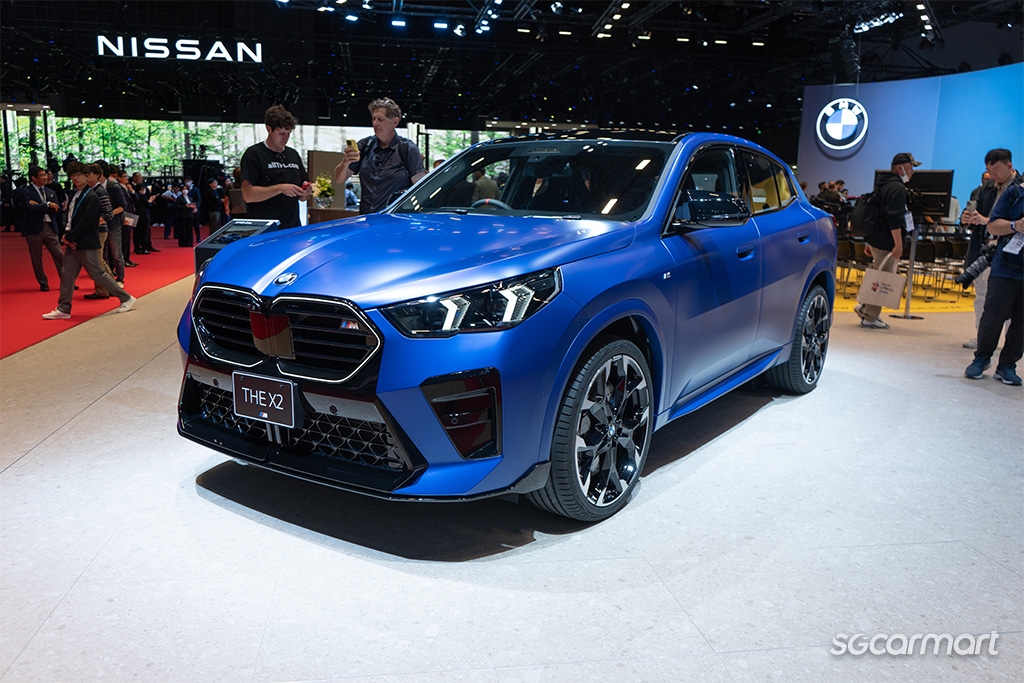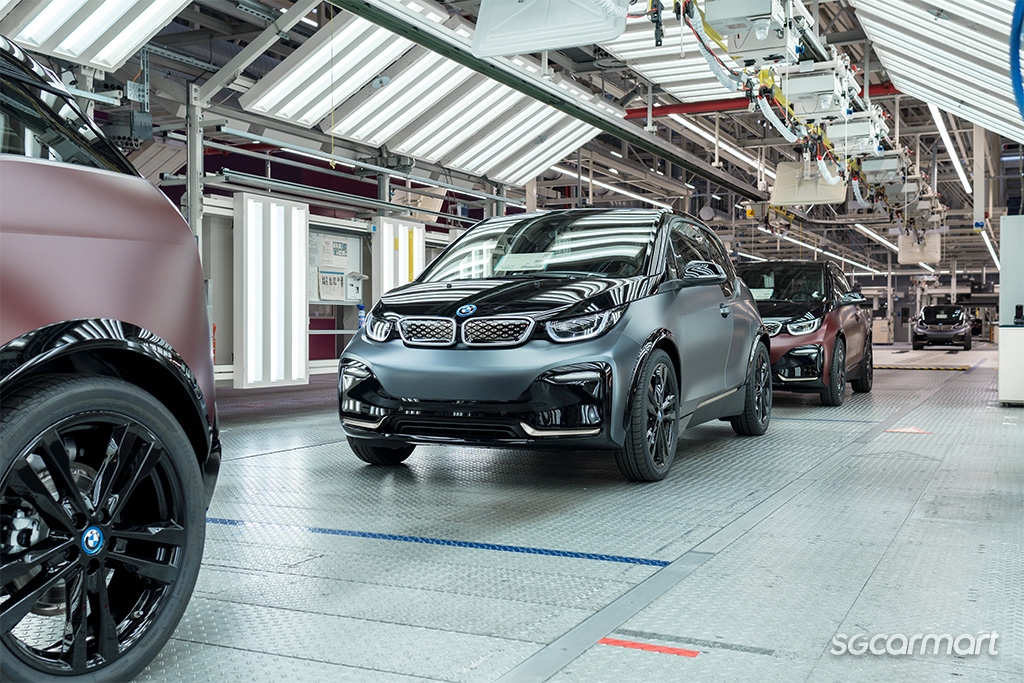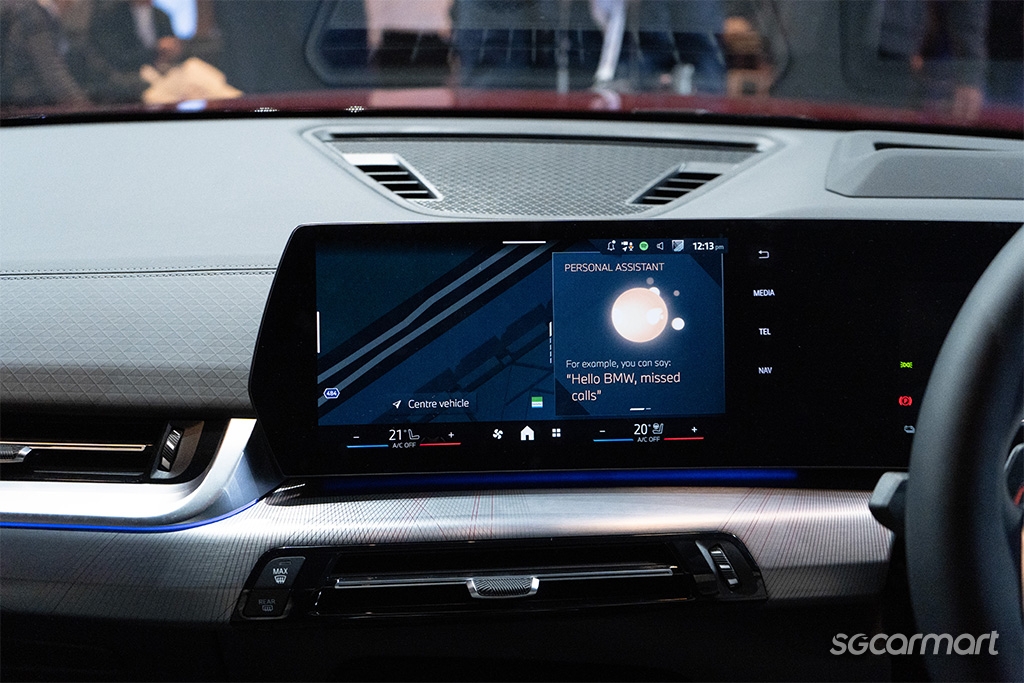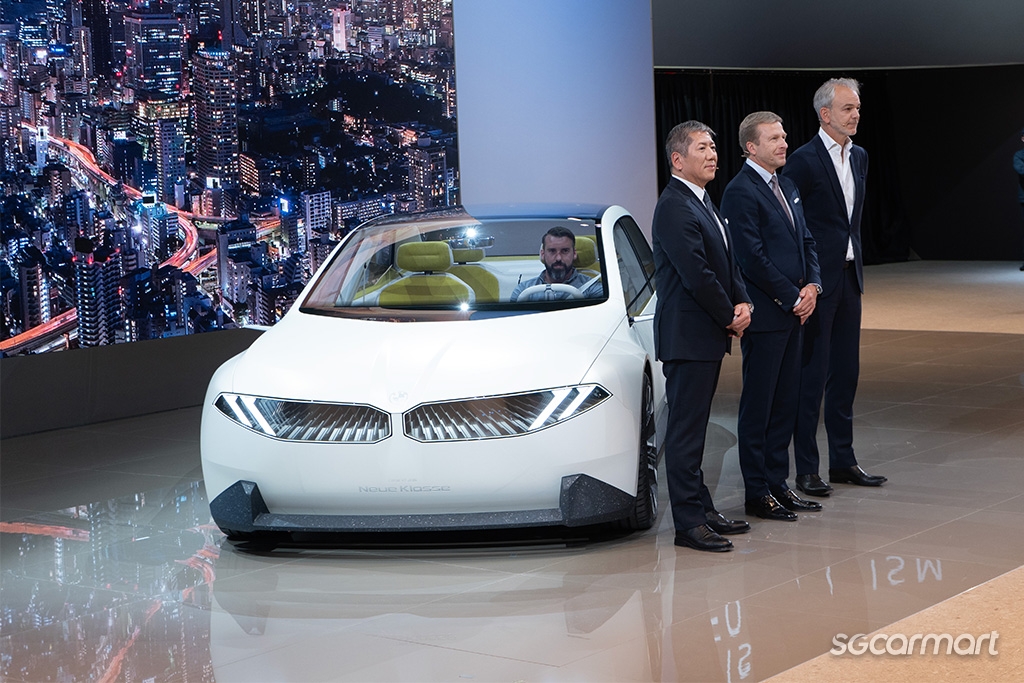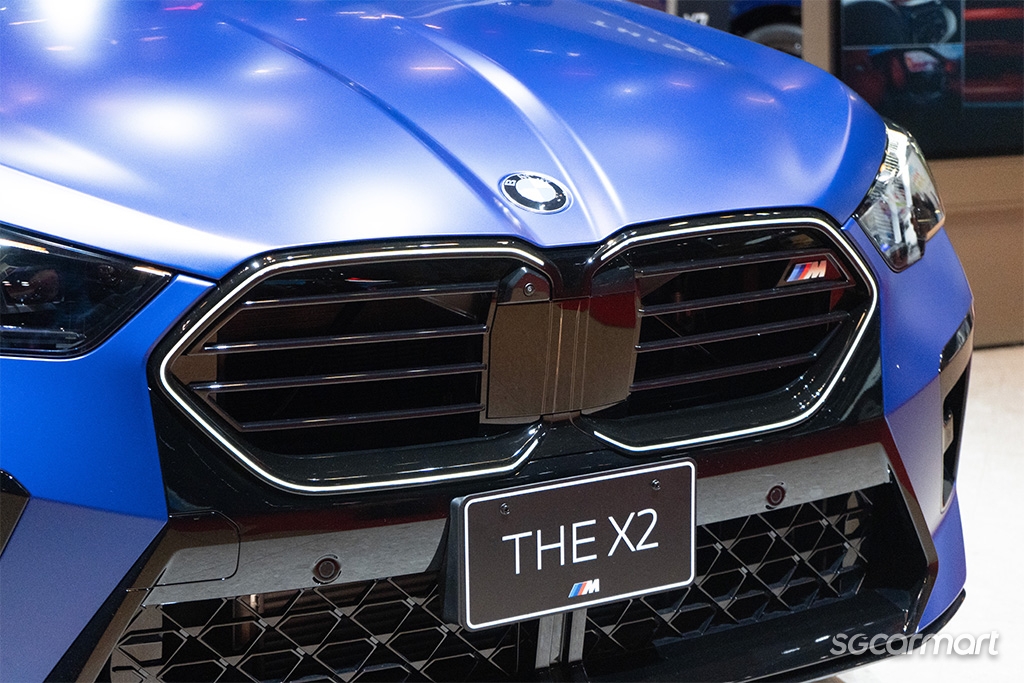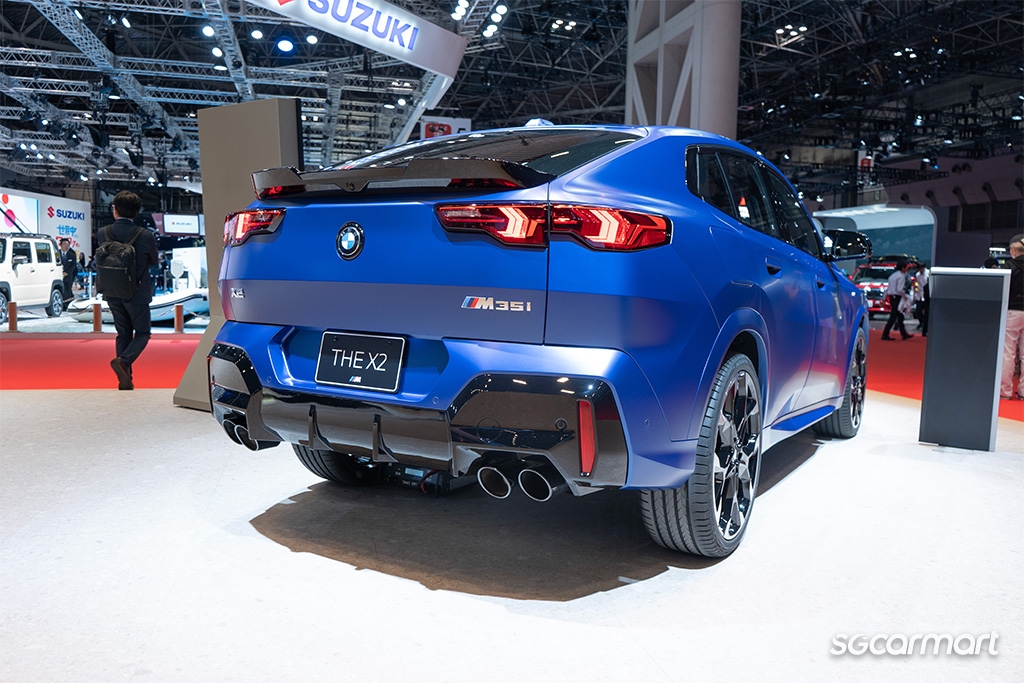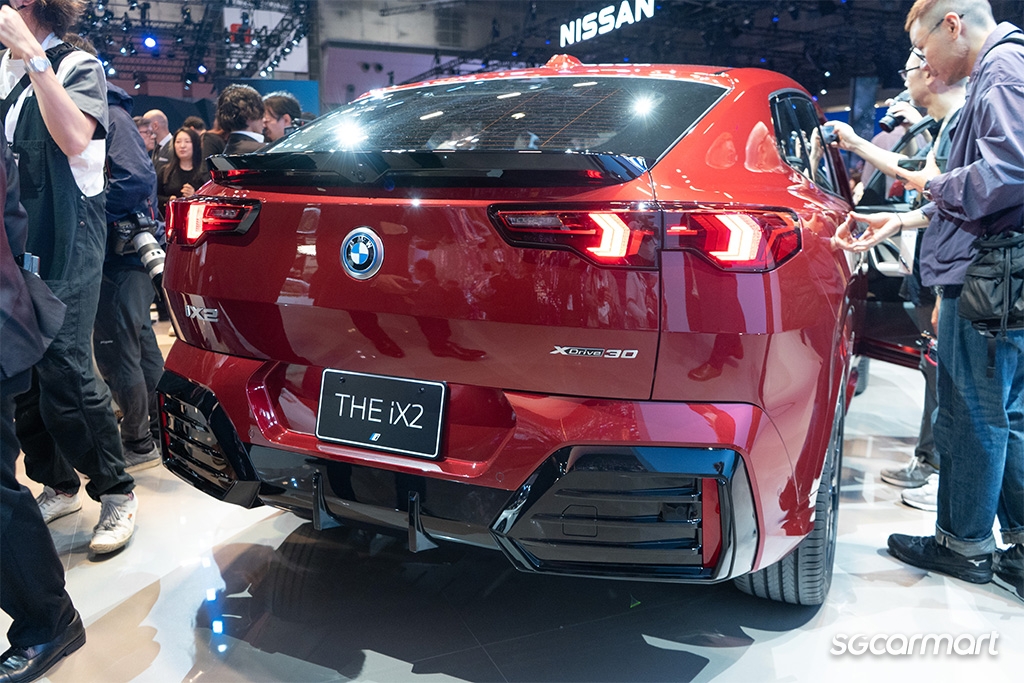Illuminating the second-gen BMW X2 - and first ever iX2
30 Oct 2023|10,818 views
The BMW X2 is not the smaller brother of the X1.
With the global physical premiere of the second generation car currently underway in Tokyo, that's something BMW hopes is now clearer than before.
Instead, look at them more as fraternal twins if you will - the latter, more subdued with its conventional crossover-styling; the former, more daring with its specially-shaped kidney grilles and coupe-SUV profile.
Clearer character
This more explicit positioning of the X1 and X2 nameplates - as two sides of a similar template - is an important precedent to gaining a deeper understanding of the car that has just broken cover at the 2023 Japan Mobility Show (JMS).
The previous generation, for all of its branding as a 'Sports Activity Coupe', didn't feel all that coupe-SUV-like. In fact, it held the distinction of having its own unique profile within the family - conforming neither to the swooping lines of its larger even-numbered X-siblings, but also not quite following the more outright boxiness of the X1, X3 and X5.
Line it up next to the X4 and X6, now, however, and it no longer stands alone. The uniformity across all three cars is now impossible to miss.
"Good. Exactly - that's what we wanted," Dr. Stefan Floeck, Senior VP of MINI and BMW Compact Class, says with a slight smile when we point the change out to him, and ask why the decision was made.
"It was quite unique on the one hand," he concedes about the first generation. "But on the other hand, we wanted to give the X2 its own clear character," he continues - almost suggesting that it had gotten lost in the shadow of the X1.
A large part of this "clear character"-strategy comes down to sheer size. The all-new X2 has grown in all directions: It's 21mm wider, 64mm taller, and a whopping 194mm longer (that's nearly 20cm!) than its predecessor. But these numbers are intentional, for they mean that the car - unlike before - is no longer the smallest X car in the family.
"Now, we can clearly position it over the X1," Stefan states. "That's very important for us. With the present progressive front and rear ends, and the strong coupe-body style, it gets more into the group of the X4 and X6 - so that we have the strong coupes, which are over the X1, X3 and X5."
The other part of the strategy, of course, comes from styling. Stefan believes that the X2 will appeal to "more progressive, extroverted" types, acknowledging: "We're trying to attract younger people with this concept as well" - such as couples. The X1, by a different token, is perhaps more family-oriented, he suggests.
Back to BMW's three-pillar strategy for the future: Electrification, digitalisation, circularity
But the arrival of the all-new X2 isn't just important as an identity-related pivot point of sorts for the nameplate.
It's also of importance because it coincides with clear (and repeated) commitments by BMW in recent times to a three-pillar strategy for the future - as well as the brand's intensifying efforts to make sure this is executed in the best iteration possible. The next foreseeable milestone? 2025, when the Neue Klasse generation hits the market, bringing with it a dedicated electric platform, and unprecedented leaps in technology and circular manufacturing principles.
Returning to the present, however, there are - of course - already the pillars of electrification and sustainability that BMW's smallest coupe-SUV embodies. Like the X1, consumers can now have the X2 fully-electrified in the form of the first-ever iX2. The first i cars - the i3 and i8 - rode on bespoke platforms, but BMW has pulled the neat trick in recent times of adapting both its front-wheel driven and rear-wheel driven architectures to offer customers the exact sort of drivetrain they desire in a car today.
That has allowed it to hold on to the combustion engine, while also giving customers fully electric (yet still wholly familiar) variants of the same model. Stefan sees the U.S.A, Europe and China as the most important markets for combustion-powered variants of the X2. The targets are slightly different for the iX2 - Europe and the Asian markets (including Japan), but he is quick to add that "in terms of driving dynamics, and the digital experience, we designed it for the world."
That brings us to the third pillar: Digitalisation.
The X2 and iX2 arrive at an ostensibly serendipitous switchover point - at which BMW is beginning deployment of the its Operating System 9. This largely relies on OS 8's look and feel (including that Curved Display), but integrates new elements to improve the touch-interface experience.
In apparent response to feedback that OS 8 can be too complex to navigate, a key tenet of OS 9 is its 'zero-layer principle', which aims to reduce menu-diving by displaying all relevant information and functions on a single level.
BMW's OS 9 (left; top) has an updated look that aims to make touch operation more intuitive (OS 8 pictured on the right; bottom)
Configurable widgets can be scrolled through vertically on the driver's side of the infotainment screen (the feature has been aptly codenamed 'QuickSelect'), and are interwoven with readjusted placements of the Home and Menu buttons - all for enhanced ease of operation. Interestingly, this is one aspect we're told will move upwards towards the Neue Klasse.
BMW also says that OS 9 was designed to serve as a jump pad for the quick and flexible integration of content based on market requirements. Somewhat controversially, perhaps, the firm is not backing down from the path of on-demand subscription services; a new BMW Digital Premium feature will unlock the in-car use of apps available in the respective countries of customers, allowing them to tap on streaming or gaming apps, but you'll have to pay for this on a monthly basis.
Stefan believes it is necessary that BMW's compact cars - such as the X2 and iX2 - offer similar digital experiences as its flagships, even going so far as to call this one of the most important lessons the firm learned from the previous generation.
"This is not a class-specific thing," he notes. "It's probably - somehow - probably even flipped around a little bit, where there is a stronger push from the bottom because you probably have the younger people there - who just expect certain digital experiences. So we have to focus on that heavily in the compact class."
No compromises for the compact class
Another of the largest trends that he sees becoming prominent in the segment in years to come is that of individualisation.
Expanding this will require a coalescence of the recent strategies BMW has tapped on, too. Tech-based services, such as My Modes, BMW Digital Premium and the natural voice-controlled Intelligent Personal Assistant promise to shape the on-road experience to the driver. On the more physical aspect, meanwhile, a new weapon (or more accurately, an old weapon wielded in new ways) has also emerged in recent times: Light.
Beyond just individually programmable welcome functions (via the head and taillights, or puddle lights for example), the manipulation of light also promises to make the car's exterior customisable to a driver's wishes - a quality that the firm seems to be hinting at already with the Vision Neue Klasse car (which was also on display at the JMS).
Today, one of the new features on the BMW X2 and iX2 already serves as a taster of that future (this also happens to be Stefan's favourite feature when we ask him to single one out on the new cars): The 'Iconic Glow' kidney grilles.
"Light is the new chrome - that's what we say at BMW," Stefan shares with visible excitement, explaining that the difficulty of implementing it in a visually pleasing manner (such that it delivers sufficient oomph when illuminated; looks just like a normal grille otherwise) has made the final iteration all the more satisfying. It's the sort of tech you'd expect to be reserved only for the flagships - but once again extended all the way to one of its more pint-sized offerings (albeit - admittedly - as an add-on option).
After all, the firm has quite the tall order of attributes it wants customers to see in its compact class cars today. When we ask what these are, Stefan launches into a long list without skipping a beat between each word: "Young, fresh, sporty, digital, cool, different, playful, circular and responsible."
BMW is hopeful that the new X2 and its multitude of flavours - from the pocket-rocket X2 M35i xDrive, to the all-electric iX2 xDrive30 - will continue expanding the appeal of its compact offerings
Whether every single compact BMW fits this bill today is admittedly debatable. But with the brand's segment offerings taken as a whole, the statement is hard to argue against. Now, with its new identity - and multitude of flavours spanning M Performance-crafted M35i xDrive to the all-electric xDrive30 - the X2 seems poised to sharpen this remit.
Here are a few other articles that may interest you!
Thrills and spills at the Japan Mobility Show 2023
The BMW X2 is not the smaller brother of the X1.
With the global physical premiere of the second generation car currently underway in Tokyo, that's something BMW hopes is now clearer than before.
Instead, look at them more as fraternal twins if you will - the latter, more subdued with its conventional crossover-styling; the former, more daring with its specially-shaped kidney grilles and coupe-SUV profile.
Clearer character
This more explicit positioning of the X1 and X2 nameplates - as two sides of a similar template - is an important precedent to gaining a deeper understanding of the car that has just broken cover at the 2023 Japan Mobility Show (JMS).
The previous generation, for all of its branding as a 'Sports Activity Coupe', didn't feel all that coupe-SUV-like. In fact, it held the distinction of having its own unique profile within the family - conforming neither to the swooping lines of its larger even-numbered X-siblings, but also not quite following the more outright boxiness of the X1, X3 and X5.
Line it up next to the X4 and X6, now, however, and it no longer stands alone. The uniformity across all three cars is now impossible to miss.
"Good. Exactly - that's what we wanted," Dr. Stefan Floeck, Senior VP of MINI and BMW Compact Class, says with a slight smile when we point the change out to him, and ask why the decision was made.
"It was quite unique on the one hand," he concedes about the first generation. "But on the other hand, we wanted to give the X2 its own clear character," he continues - almost suggesting that it had gotten lost in the shadow of the X1.
A large part of this "clear character"-strategy comes down to sheer size. The all-new X2 has grown in all directions: It's 21mm wider, 64mm taller, and a whopping 194mm longer (that's nearly 20cm!) than its predecessor. But these numbers are intentional, for they mean that the car - unlike before - is no longer the smallest X car in the family.
"Now, we can clearly position it over the X1," Stefan states. "That's very important for us. With the present progressive front and rear ends, and the strong coupe-body style, it gets more into the group of the X4 and X6 - so that we have the strong coupes, which are over the X1, X3 and X5."
The other part of the strategy, of course, comes from styling. Stefan believes that the X2 will appeal to "more progressive, extroverted" types, acknowledging: "We're trying to attract younger people with this concept as well" - such as couples. The X1, by a different token, is perhaps more family-oriented, he suggests.
Back to BMW's three-pillar strategy for the future: Electrification, digitalisation, circularity
But the arrival of the all-new X2 isn't just important as an identity-related pivot point of sorts for the nameplate.
It's also of importance because it coincides with clear (and repeated) commitments by BMW in recent times to a three-pillar strategy for the future - as well as the brand's intensifying efforts to make sure this is executed in the best iteration possible. The next foreseeable milestone? 2025, when the Neue Klasse generation hits the market, bringing with it a dedicated electric platform, and unprecedented leaps in technology and circular manufacturing principles.
Returning to the present, however, there are - of course - already the pillars of electrification and sustainability that BMW's smallest coupe-SUV embodies. Like the X1, consumers can now have the X2 fully-electrified in the form of the first-ever iX2. The first i cars - the i3 and i8 - rode on bespoke platforms, but BMW has pulled the neat trick in recent times of adapting both its front-wheel driven and rear-wheel driven architectures to offer customers the exact sort of drivetrain they desire in a car today.
That has allowed it to hold on to the combustion engine, while also giving customers fully electric (yet still wholly familiar) variants of the same model. Stefan sees the U.S.A, Europe and China as the most important markets for combustion-powered variants of the X2. The targets are slightly different for the iX2 - Europe and the Asian markets (including Japan), but he is quick to add that "in terms of driving dynamics, and the digital experience, we designed it for the world."
That brings us to the third pillar: Digitalisation.
The X2 and iX2 arrive at an ostensibly serendipitous switchover point - at which BMW is beginning deployment of the its Operating System 9. This largely relies on OS 8's look and feel (including that Curved Display), but integrates new elements to improve the touch-interface experience.
In apparent response to feedback that OS 8 can be too complex to navigate, a key tenet of OS 9 is its 'zero-layer principle', which aims to reduce menu-diving by displaying all relevant information and functions on a single level.
BMW's OS 9 (left; top) has an updated look that aims to make touch operation more intuitive (OS 8 pictured on the right; bottom)
Configurable widgets can be scrolled through vertically on the driver's side of the infotainment screen (the feature has been aptly codenamed 'QuickSelect'), and are interwoven with readjusted placements of the Home and Menu buttons - all for enhanced ease of operation. Interestingly, this is one aspect we're told will move upwards towards the Neue Klasse.
BMW also says that OS 9 was designed to serve as a jump pad for the quick and flexible integration of content based on market requirements. Somewhat controversially, perhaps, the firm is not backing down from the path of on-demand subscription services; a new BMW Digital Premium feature will unlock the in-car use of apps available in the respective countries of customers, allowing them to tap on streaming or gaming apps, but you'll have to pay for this on a monthly basis.
Stefan believes it is necessary that BMW's compact cars - such as the X2 and iX2 - offer similar digital experiences as its flagships, even going so far as to call this one of the most important lessons the firm learned from the previous generation.
"This is not a class-specific thing," he notes. "It's probably - somehow - probably even flipped around a little bit, where there is a stronger push from the bottom because you probably have the younger people there - who just expect certain digital experiences. So we have to focus on that heavily in the compact class."
No compromises for the compact class
Another of the largest trends that he sees becoming prominent in the segment in years to come is that of individualisation.
Expanding this will require a coalescence of the recent strategies BMW has tapped on, too. Tech-based services, such as My Modes, BMW Digital Premium and the natural voice-controlled Intelligent Personal Assistant promise to shape the on-road experience to the driver. On the more physical aspect, meanwhile, a new weapon (or more accurately, an old weapon wielded in new ways) has also emerged in recent times: Light.
Beyond just individually programmable welcome functions (via the head and taillights, or puddle lights for example), the manipulation of light also promises to make the car's exterior customisable to a driver's wishes - a quality that the firm seems to be hinting at already with the Vision Neue Klasse car (which was also on display at the JMS).
Today, one of the new features on the BMW X2 and iX2 already serves as a taster of that future (this also happens to be Stefan's favourite feature when we ask him to single one out on the new cars): The 'Iconic Glow' kidney grilles.
"Light is the new chrome - that's what we say at BMW," Stefan shares with visible excitement, explaining that the difficulty of implementing it in a visually pleasing manner (such that it delivers sufficient oomph when illuminated; looks just like a normal grille otherwise) has made the final iteration all the more satisfying. It's the sort of tech you'd expect to be reserved only for the flagships - but once again extended all the way to one of its more pint-sized offerings (albeit - admittedly - as an add-on option).
After all, the firm has quite the tall order of attributes it wants customers to see in its compact class cars today. When we ask what these are, Stefan launches into a long list without skipping a beat between each word: "Young, fresh, sporty, digital, cool, different, playful, circular and responsible."
BMW is hopeful that the new X2 and its multitude of flavours - from the pocket-rocket X2 M35i xDrive, to the all-electric iX2 xDrive30 - will continue expanding the appeal of its compact offerings
Whether every single compact BMW fits this bill today is admittedly debatable. But with the brand's segment offerings taken as a whole, the statement is hard to argue against. Now, with its new identity - and multitude of flavours spanning M Performance-crafted M35i xDrive to the all-electric xDrive30 - the X2 seems poised to sharpen this remit.
Here are a few other articles that may interest you!
Thrills and spills at the Japan Mobility Show 2023
Thank You For Your Subscription.

















